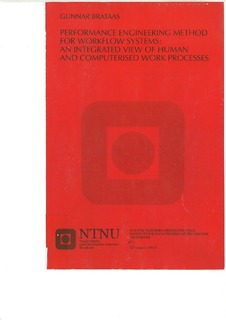| dc.contributor.author | Brataas, Gunnar | nb_NO |
| dc.date.accessioned | 2014-12-19T13:29:21Z | |
| dc.date.available | 2014-12-19T13:29:21Z | |
| dc.date.created | 1996-12-11 | nb_NO |
| dc.date.issued | 1996 | nb_NO |
| dc.identifier | 122120 | nb_NO |
| dc.identifier.isbn | 82-7119-950-1 | nb_NO |
| dc.identifier.uri | http://hdl.handle.net/11250/249687 | |
| dc.description.abstract | A method for designing workflow systems which satisfy performance requirements is proposed in this thesis. Integration of human and computerised performance is particularly useful for workflow systems where human and computerised processes are intertwined. The proposed framework encompasses human and computerised resources.
Even though systematic performance engineering is not common practice in information system development, current, best practice shows that performance engineering of software is feasible, e.g. the SPE method by Connie U. Smith. Contemporary approaches to performance engineering focus on dynamic models of resource contention, e.g. queueing networks and Petri nets. Two difficulties arise for large-scale information systems. The first difficulty is to estimate appropriate parameters which capture the properties of the software and the organisation. The second difficulty is to maintain an overveiw of a complex model, which is essential both to guide the choice of parameters and to ensure that the oerformance engineering process is an intregal part of the wider system development process.
The proposed method is based on the static performance modelling method Structure and Performance (SP) developed by Peter h: Hughes. SP provides a suitable bridge between contemporary CASE tools and traditional dynamic approaches to performance evaluation, in particular because it adresses the problems of parameterisation and overveiw identified above.
The method is explored and illustrated with two case studies. The Blood Bank Case Study comprised performance engineering of a transaction-oriented information system, showing the oractical feasibility of integrating the method with CASE tools. The Gas Sales Telex Administration Case Study for Statoil looked at performance engineering of a workfloww system for telex handling, and consisted of performance modelling of human activity in interaction with a Lotus Notes computer platform.
The latter case study demonstrated the feasibility of the framework. | nb_NO |
| dc.language | eng | nb_NO |
| dc.publisher | Fakultet for informasjonsteknologi, matematikk og elektroteknikk | nb_NO |
| dc.relation.ispartofseries | Dr. ingeniøravhandling, 0809-103X; 1996:62 | nb_NO |
| dc.subject | arbeidsorganisering | no_NO |
| dc.subject | Datamaskinprogrammer | no_NO |
| dc.subject | Brukergrensesnitt | no_NO |
| dc.title | Performance engineering method for workflow systems : an integrated view of human and computerised work processes | nb_NO |
| dc.type | Doctoral thesis | nb_NO |
| dc.source.pagenumber | 237 | nb_NO |
| dc.contributor.department | Norges teknisk-naturvitenskapelige universitet, Fakultet for informasjonsteknologi, matematikk og elektroteknikk | nb_NO |
| dc.description.degree | dr.ing. | nb_NO |
| dc.description.degree | dr.ing. | en_GB |
